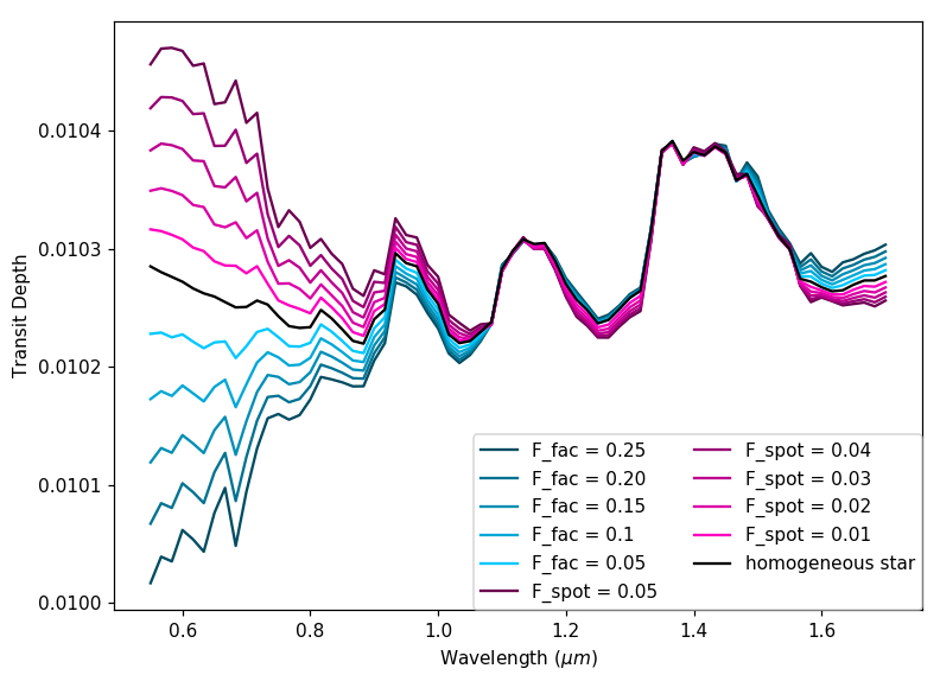Characterising the Effects of Active Host Stars on Exoplanet Transmission Spectra in Retrieval
- 1Department of Physics and Astronomy, University College London, Gower Street, WC1E 6BT London, United Kingdom (alex.thompson.17@ucl.ac.uk)
- 2INAF- Palermo Astronomical Observatory, Piazza del Parlamento, 1, 90134 Palermo, Italy
With over 5000 confirmed exoplanetary detections so far, the characterisation of these new worlds is arguably more important than ever. The imminent arrival of the first JWST observations, followed by the launch of the exoplanet-dedicated Ariel mission towards the end of the decade, means that the key goal of the exoplanet scientific community is ensuring that we can extract as much information from these observations as possible. In recent years, attention has been brought to the importance of accurately characterising exoplanet host stars. Excluding the small number of planets that are favourable to direct imaging, the star-planet system is observed as a blended source. These intertwined planetary and stellar signals can only be successfully disentangled with sufficiently complex stellar models and external, supplementary observations of the stellar properties. One of the largest ways in which the host star can contaminate exoplanet transmission spectra is tied to its activity. Active F-M dwarfs are expected to be characterised by heterogeneous photospheres due to the presence of cool spots and hot faculae generated by their magnetic fields. These active regions result in contamination regardless of if they are occulted or unocculted. Their presence causes the transit chord to deviate from the pre-transit disk integrated stellar spectrum, the assumed light source for transmission spectroscopy. This contamination also varies strongly as a function of wavelength with the strongest contamination observed in the optical regime (Fig. 1). Inaccurate or incomplete treatments of the star can therefore lead to significant biases in the retrieved planetary and atmospheric parameters.
In contrast to unocculted features, occulted features are much easier to identify and correct for at the light curve fitting stage. This work focuses on quantifying the effects of unocculted spots and faculae by using the exoplanet retrieval code TauREx 3 to fit for parameters related to stellar activity, the covering fractions and temperatures of spots/faculae, for both existing observations and for JWST and Ariel simulations. Subsequently, the probability of the host star being active can be constrained through analysis of the Bayes factor. Overall, it is still rare that stellar parameters are considered in retrievals and this work firmly advocates for a greater exploration of combined stellar and planetary retrievals. The efficacy of the activity plugin is demonstrated through simulations, for which the input stellar parameters are already known. The plugin has also been used extensively to analyse HST STIS spectra for WASP-17b (Saba et al. 2022).
After demonstrating a simplified, proof-of-concept correction method for stellar activity in TauREx 3, subsequent focus has been on implementing a more realistic stellar model in order to better capture the degeneracies that spots may introduce. This is being conducted in collaboration with the INAF Palermo Royal Observatory with the model taking into account the increased complexity of limb darkening and the use of fixed spot positions on the stellar disk (Fig. 2). A comparison between the two models will be presented to quantify the benefits of using a more realistic stellar model and validate the increased complexity with a particular focus on JWST and Ariel simulations.

Fig. 1 - Forward model transmission spectra for a hot-Jupiter (RP = 1 RJup , MP = 1 MJup , TP = 1000K, log(H2O)= -3) orbiting a K5V host star with a photospheric temperature of 4450K. The models show how the stellar contamination varies as a function of increasing covering fractions of spots (3480K) or faculae (4550K). Temperatures of the three stellar components (spots, faculae and quiet photosphere) are taken from Rackham et al. (2018).
Fig. 2 – Left: The position of two large spots on the photosphere with co-ordinates of 10°N, 10°E and 30°N, 30°E and radii of 0.1R* and 0.2 R* respectively. The temperature contrast between the spots and the photosphere is 1000K. Right: The effect of these two spots on the intensity profiles at 1.7μm (orange) and 5.2μm (blue). The impact of the spots is greater at shorter wavelengths due to the heightened effects of limb darkening.
How to cite: Thompson, A., Saba, A., Changeat, Q., Tinetti, G., Cracchiolo, G., and Micela, G.: Characterising the Effects of Active Host Stars on Exoplanet Transmission Spectra in Retrieval , Europlanet Science Congress 2022, Granada, Spain, 18–23 Sep 2022, EPSC2022-266, https://doi.org/10.5194/epsc2022-266, 2022.

